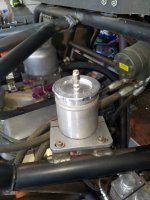As long as it has been working for you, there's no real harm in what you have setup there but assuming that the valve you have on that pipe nipple is strictly a check valve with a few PSI cracking pressure, then it will vent air as thermal expansion causes the oil fill level to rise. Once you shut the engine off and the oil cools back down to its original fill level, the reservoir will be under vacuum unless you have a way to let atmospheric air back in, which that valve alone will not do. It's not the end of the world but not ideal as the next time you start up, the pump will be more likely to cavitate until the oil warms up and reaches positive pressure again. This will affect larger displacement and higher flow pumps more noticeably than lower flow ones.
The other thing I notice about the valve setup you have done is that you have the sintered bronze filter facing up so in the desert, this is not a big deal but in wet environments with mud and rain, water can collect in the body of that filter/check valve. Venting action of that valve should only be in one direction so it shouldn't allow water to drip down into the reservoir but it's simply a risk.
My new remote breather/pressure valve that I will be sharing this week performs a more similar function to a radiator cap. It builds pressure in one direction, acting as a pressure relief, but as oil cools down it allows atmospheric air to flow back in so that the reservoir can only ever be between 0 and 10 PSI. With push lock fittings in and out, you can run the vent hose outlet to a safer location where, in the rare event of an oil discharge, it can be contained or at least discharged away from heat sources, and it will be less likely for water/dust ingress to occur.
Again, there isn't a definitive right or wrong answer and what has worked for you may not work ideally in every case. When I was redesigning this reservoir with a blank slate for cap/pressure control hardware, this new setup is what I concluded to be the simplest and most reliable solution to achieve my main objectives of: positive seal, oil trap, rollover valve, pressure relief, and anti-vacuum.
